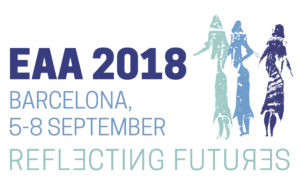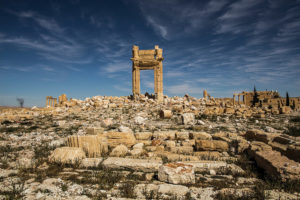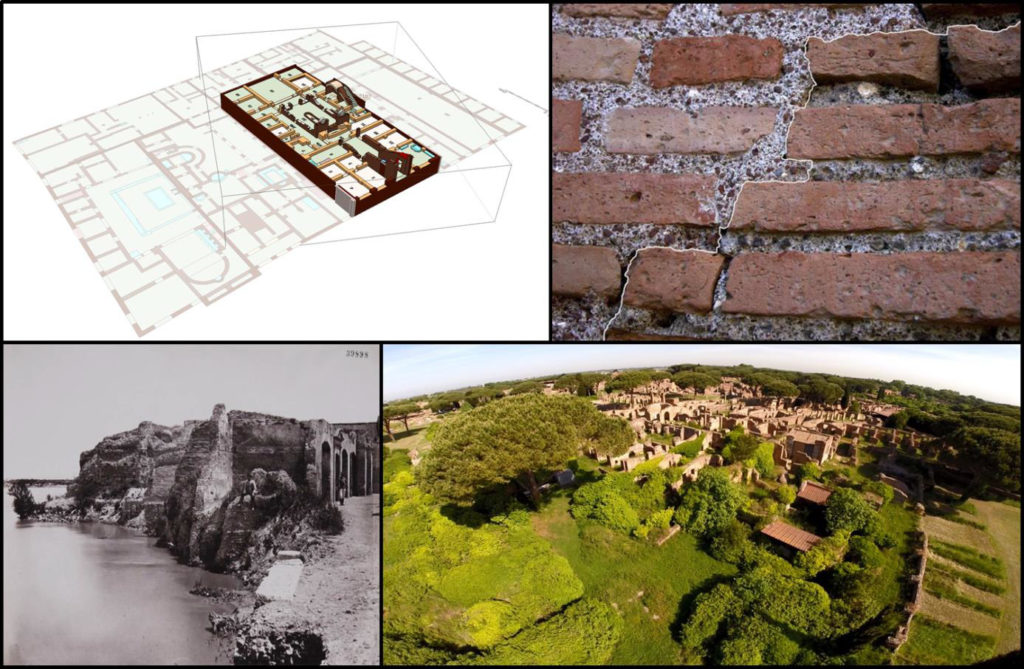2019
 EAA 2019: Beyond Paradigms
EAA 2019: Beyond Paradigms
Bern, 4-7 September 2019
Conference website
Daniel Turner
Poster presentation: Sunk costs: Multiuse tombs in eleventh century BC Achaea
Hayley Mickleburgh, Victor Klinkenberg and Sarah Gluschitz
Understanding human burial taphonomy through actualistic experiments and 3D data collection and analysis techniques
Climate and Society in Ancient Worlds: Diversity in Collapse and Resilience
Brussels, 22-24 May 2019
Conference website
Ann Brysbaert and Riia Timonen
Saving up for a rainy day? Climate events, human-induced processes, and their potential effects on people’s coping strategies in the Late Bronze Age Mycenaean Argive Plain, Greece
This chapter investigates the resilience and risk management strategies of the Late Bronze Age (LBA) people against changing climatic conditions and other potential stress factors, such as monumental construction programmes, that led to the socio-political and economic crises which took place in the Eastern Mediterranean ca. 1200 BC.

CAA 2019: Check Object Integrity
Kraków, 23-27 April 2019
Conference website
Victor Klinkenberg and Riia Timonen
The missing landscape of the Mycenaean Argive Plain
The core area of the Mycenaean civilization, the Argive Plain in Greece, is famous for its monumental citadels and burial tombs from the Late Bronze Age. Much less is known about the general population and the ancient landscape, due to a research focus on the citadels and to large-scale sedimentation in the plain, which deeply buried the Mycenaean surfaces. We use GIS to specify how these research- and geomorphological biases influence our knowledge of the Argive Plain and attempt to quantify what is missing. We present a revised landscape model for the region, based on geology, geomorphology and ancient and modern land use. After drawing a parallel with neighbouring regions, where pedestrian surveys were carried out, we suggest that earlier interpretations of the Argive Plain as an urbanized landscape is in need of revision.
Jari Pakkanen and Ann Brysbaert
Teaching 3D archaeological documentation in the field and classroom
The 3D field-documentation courses of the Finnish Institute at Athens were started in 2014 and they have been run at the Bronze Age site of Tiryns in the Argolid and at the Archaic to Hellenistic town at Ambelakia on Salamis. Their aim has been to train students without previous experience in archaeological documentation to work with reflectorless total stations and photogrammetry.
In 2014–2016 and 2018 these courses and fieldwork were run in collaboration with Leiden University. In these field-courses students were introduced to both equipment and software used in intensive 3D feature-by-feature documentation. They learn to use reflectorless total stations as a drawing tool and the advantages the method has over traditional static total station work with prism. The second technique taught was photogrammetry, including how to combine the produced line-documentation with photogrammetry models. Students quickly learned the principles of 3D work and how to use the hardware and post-processing software. Behind the fast learning process lies in the one-to-one teaching and the hands-on work with in-situ archaeological remains. The time in the field and number of repetitions need to be intense enough so that the procedures become automatic.
This paper aims to illustrate the field-course processes and how used methods have developed over the years. It discusses how the obtained skills have fed into the subsequent studies and research of the students and colleagues who have participated. Teaching on the field courses is compared with running classroom-based 3D documentation teaching at Royal Holloway, University of London.
Ann Brysbaert
“Welcome to the Aegean Bronze Age”: Computer-enhanced Open Access in archaeological research
Few landscapes have been so intensively modified over time than that of the Argolid (Greece) since at least the Early Bronze Age and certainly in the Mycenaean Late Bronze Age (c. 1600-1100 BCE). The ERC-funded CoG project, SETinSTONE, investigates if and how monumental building activities undertaken there may have impacted on the social, economic and political structures of the Mycenaean polities in this period, and how people responded to changes in these structures.
The overall team investigates (1) the minimum levels of human and material resources input in the prolonged building efforts present in this region between c. 1300-1200 BC, and what happened to these resources; (2) what subsistence strategies and other activities people were undertaking in this period, and what resources they had at their disposal. Mobility and access to resources, for agricultural and building activities, were crucial factors in daily life. The subproject of both authors investigates and assesses the usability of past infrastructure and routes to transport resources between the region’s major hubs.
In line with the ERC request for Open Access in publishing project results, we went one step further in employing devices and open- source software (OSS) that everyone has access to during our walks in this landscape while checking published remains. This paper demonstrates that our research enhances and advocates total Open Access for anyone who is willing to persevere in taking available hard/software to new levels. We believe that such an approach makes this landscape even more accessible to all.
2018
 EAA 2018: Reflecting Futures
EAA 2018: Reflecting Futures
Barcelona, 5-8 September 2018
Conference website
Riia Timonen and Victor Klinkenberg
Feeding the masses: Environmental resources and agricultural potential in the Argive Plain, Greece
Towards the end of the Bronze Age (ca. 1600-1100 BCE) the Greek mainland witnessed large-scale socio-political changes such as the development of administrative organizations, expanding international trade and a dramatic population growth. This resulted in increased subsistence requirements which were met with agricultural intensification and other changes in land use patterns. One of the regions where these societal transformations are prominently visible is the Argive Plain in the Peloponnese. The area is renowned for the architectural and artistic achievements observed at monumental sites such as Mycenae and Tiryns. Much less is known about the land use, subsistence strategies, or the food economy of the people living in and around these major sites.
To come to a better understanding of these factors of daily life, we bring together data on the resource availability and settlement patterns of this important agricultural landscape and discuss (1) the agricultural potential or carrying capacity of the Argive Plain and (2) how the landscape was used to secure basic subsistence and, possibly, surplus production. To achieve this we combine available data provided by archaeobotanical, and environmental (e.g. climatic and geographical) studies. These data are contextualized in their cultural landscape. To this end we also present a critical revaluation of available settlement data obtained from surveys and excavations. This results in an up-to-date overview of the Bronze Age subsistence economy, set in its ancient cultural landscape.
AIAC 2018: 19th International Congress of Classical Archaeology
Cologne/Bonn, 22-26 May 2018
Conference website
Daniel Turner
Constructing multi-use tombs in Late Bronze Age Attica and Achaea
In the late second millennium BC, Mycenaeans dug large tombs into hillsides with speed and precision. Many of these chamber and tholos tombs take an iconic shape: 1) a narrow passage (dromos) leading to a façade pierced by 2) a bottleneck entrance (stomion) closed with a rubble wall. Through the stomion lies 3) a vaulted chamber (thalamos) many times the size required for interring bodies and possessions. Digging such extravagant, multi-use tombs required strength, coordination, and confidence. Both the initial construction and subsequent reopening(s) created a spectacle similar to cyclopean wall construction, albeit at a smaller scale. Reconstructing that process has simplified with advances in photogrammetry and comparative labor costs. This paper combines photogrammetric models and comparative labor costs to discuss tomb construction at sites in Achaea and Attica.
Yannick Boswinkel
Breaking down monumental constructions: people, costs and techniques
Studying monumentality has many issues, partly because it is such an ambiguous term. However, if one accepts the monumentality of a construction as being bigger and better relative to contemporary structures there might be a means to compare structures. To be able to compare size and quality, one could quantify a structure based on the necessary labour-investments. Quantifying monumentality through labour-cost studies is not new and has been criticized as well as celebrated in the past. By breaking down a structure to its individual components and how these came to be, it is possible to get an estimate of the workforce that was needed for different stages like quarrying and transporting the material as well as for the actual construction of the building. One of the issues with such studies is the sheer amount of assumptions that are needed at every step of the process of calculating a total sum of investment. A case study from Mycenaean Greece (±1600-1100 BC) will be presented in which fortification walls have been recorded in 3D with high accuracy, using Total Stations and photogrammetry. It will be evaluated whether such high precision recording can add anything to the quality of the labourcost analysis. If the quality can be increased, then this might increase the usability and the reliability of labour-cost analyses. Ultimately, it might improve our understanding of monumental constructions.
Ann Brysbaert
Crafting as making, thinking and being (together)
In the prehistoric east Mediterranean, hierarchical societies developed technological systems and production processes for both quotidian and prestige and luxury items. This paper addresses questions about how artisans reacted to and interacted with specific production demands linked to elites’ identity formation and reconfirmation practices, while they were perhaps also forming their own identities through crafting.
Crafting or making is connecting and performing: materials to each other, people to each other, people to materials, materials to people. Crafting is both technical and social and creates distinction. Someone who is very skilled through life-long practicing develops differently than someone who does not. Sociotechnical distinctions are thus logical consequences of making and are linked to value attributions at various levels. Value ascription may differ according to social groups and may be both inclusive and exclusive. How can we identify such socio-technical processes and practices, and their consequences, how can we define the role(s) that craftspeople played in the socio-political and economic contexts of elitebased societies, and are these always as clear-cut as usually portrayed? Processes of value ascription to crafting in Aegean BA contexts are compared to contemporary craft contexts in order to understand whether such values and value ascriptions are universal or context-specific.
2017
EAA 2017: Building Bridges
Maastricht, 30 August – 3 September 2017
Conference website
Ann Brysbaert and Anna Gutierrez Garcia-M
Session hosting: Construction economies of the past. New approaches to their societal, political and long-term impact (272)
Our 21st century construction industry links largely to economic growth by its scale and its driving force, and, inevitably, it has a serious impact on the global economy. Requiring financial investment already during design stages, all construction processes are labour-intensive, provide jobs, and can lead to an increasing quality of life and buying power. In past pre-industrial societies whenever large-scale building projects took place, extensive manual labour was invested from the moment materials were scouted for, extracted, transported, employed and subsequently maintained. Since most pre-industrial societies were subsistence societies, important decision-making was a daily balancing act between building work and agriculture.
This session collects widely ranging papers, covering archaeological, experimental, historical and ethnographic/anthropological perspectives. These address the socio-economic and political decision-making needed for construction projects to materialize in many different past contexts. We aim to contribute responses to the following questions:
- How were large-scale buildings constructed from both a material and a logistical perspective, how can we document this?
- How and why were these buildings subsequently used by the various groups?
- What levels of investment, human and other, were needed to achieve and sustain these constructions?
- How can we measure these investments and employ these results meaningfully (for what?)?
- Which sources of data are useful to approach both socio-economic and political issues involved in constructing?
- Given that construction took place diachronically and geographically more or less worldwide, can we recognise common denominators, and which are these? How can
multidisciplinary approaches further this research?
Ann Brysbaert
On the road again. The impact of transport logistics and infrastructure in monumental building efforts
The question as to how large-scale buildings were constructed from both a material and a logistical perspective is central in this introduction paper which will focus specifically on transport issues in Late Bronze Age Greece. In past pre-industrial societies whenever large-scale building projects took place, extensive manual labour was invested from the moment materials were scouted for, extracted, transported, employed and subsequently maintained in the upkeep of the building complex and its subsequent modifications. Specific case studies in which these modifications were substantial enough to continue to mobilise relatively large or specific workforces will be presented.
However, since most pre-industrial societies were subsistence societies, important decision-making relating to engaging such resources again and again had to be a daily balancing act between building work and agriculture. Specifically, the logistics needed to set up the infrastructure to transporting the construction materials as part of the building processes, and how these link to other essential spheres of life, impacted the involved resources to an important degree in which common denominators may be recognised diachronically and geographically. While the economic demands of transport were often high in the highlighted examples, they were nevertheless considered viable from a socio-political viewpoint. The balancing act between building and subsistence activities needs to be seen, therefore, in its wider context.
Hanna Stöger
The impact of large scale construction on Roman cities. Would our planning authorities approve them?
Most of today’s large building projects in urban and in rural contexts undergo strict planning processes and require official approval by the local planning authorities before development can commence. Can we imagine similar processes for antiquity? Would most of the larger Roman projects have been approved had they been exposed to a strict environmental impact assessment as today’s large-scale developments?
The proposed presentation uses Ostia, the port-town of Imperial Rome, as a case study to explore the impact of large-scale public or semi-public buildings on the existing urban environment. Examples to be discussed include the mid-second century AD Forum baths of Ostia. This thermal complex extended over almost a quarter of the original city centre, while a number of earlier streets had to be cancelled and preceding city blocks had to give way to the new development. Other examples come from Ostia’s late antique exedra, a semi-circular area with colonnades and water features located on the southern side of the decumanus, the city’s mayor east-west axis. When it was installed there, it blocked a previously important street, cutting off the connection from the decumanus to the south-eastern city gate. We can also think of Ostia’s Case a Giardino, a lavishly planned housing estate similar in conception to our gated communities. Within a short period after its completion, a number of its residential buildings were converted into commercial and industrial premises. Did this project fail to meet the requirements of the local housing market, or was it too ambitious to be sustained in the long run? Next to the physical impact of such construction on the immediate and the wider city we also need to assess the economic bearings they had on the city. The paper seeks to encourage a discussion which bridges present and past concerns about ‘sustainable’ urban development.
 Centre for Digital Heritage meeting:
Centre for Digital Heritage meeting:
Heritage Under Threat
Leiden, 14-16 June 2017
Programme
Hanna Stöger, Mark Locicero, Alexander Jansen
3D Visualizations and Ostia
Given the endangered heritage situations arising from dramatic contemporary conflicts, we tend to forget about well-known familiar archaeological sites closer to home. Key sites of Roman urban culture such as Pompeii and Ostia occasionally appear in the news when buildings collapse or the sites are completely closed off due to flooding. Slow, on-going processes of deterioration resulting from exposure to the elements and every day wear and tear caused by an endless stream of visitors hardly ever make the news. Most Mediterranean countries are blessed with high densities of archaeological sites and finds. Yet, these cultural assets turn from a blessing to a curse when budget-cuts occur and local or regional heritage agencies have difficulty assuring sufficient protection and sustainable site management.
A case study of a city block from Ostia (insula V, ii), and examples from other parts of the city will be used to address a number of issues the site is confronted with. This city block is one of the best researched in the Roman world, and its original model from the 1970s (published in 1984), has recently been reassessed by several researchers from Leiden’s Faculty of Archaeology (H. Stöger, M. Locicero, A. Jansen). This research brings together the pressing challenges of climate change, archaeological conservation, and sustainable heritage management, while presenting opportunities at all scales of research (including 3D modelling, space syntax analysis, building information modelling (BIM), as well as the assessment of the block’s water infrastructure). Although it doesn’t often make newspaper headlines, the wealth of urban archaeological data within Europe continues to require new forms of research, assessment, and management in our increasingly urbanized world.
